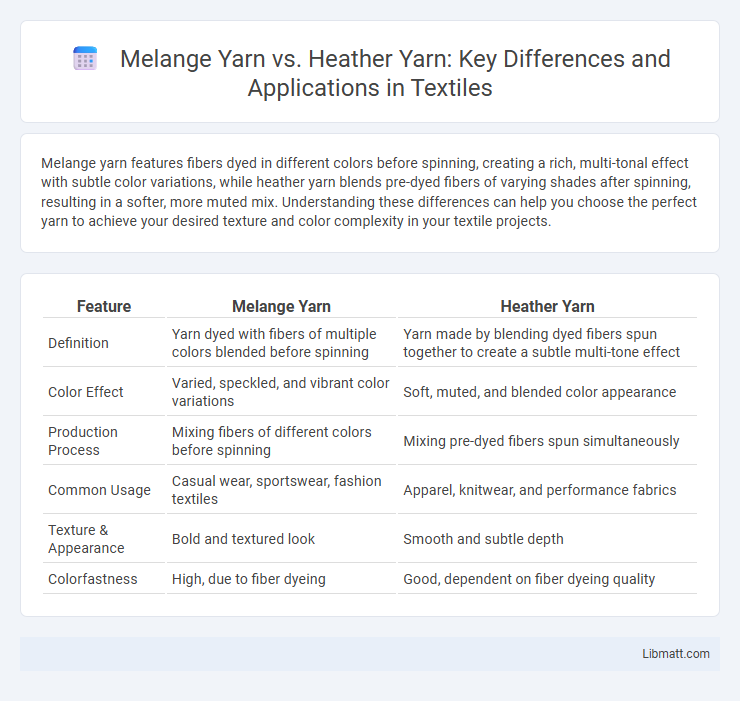Melange yarn features fibers dyed in different colors before spinning, creating a rich, multi-tonal effect with subtle color variations, while heather yarn blends pre-dyed fibers of varying shades after spinning, resulting in a softer, more muted mix. Understanding these differences can help you choose the perfect yarn to achieve your desired texture and color complexity in your textile projects.
Table of Comparison
| Feature | Melange Yarn | Heather Yarn |
|---|---|---|
| Definition | Yarn dyed with fibers of multiple colors blended before spinning | Yarn made by blending dyed fibers spun together to create a subtle multi-tone effect |
| Color Effect | Varied, speckled, and vibrant color variations | Soft, muted, and blended color appearance |
| Production Process | Mixing fibers of different colors before spinning | Mixing pre-dyed fibers spun simultaneously |
| Common Usage | Casual wear, sportswear, fashion textiles | Apparel, knitwear, and performance fabrics |
| Texture & Appearance | Bold and textured look | Smooth and subtle depth |
| Colorfastness | High, due to fiber dyeing | Good, dependent on fiber dyeing quality |
Introduction to Melange Yarn and Heather Yarn
Melange yarn is created by blending fibers of different colors before spinning, producing a soft, muted, and multi-tonal effect ideal for subtle texture in fabrics. Heather yarn, on the other hand, combines fibers with varying shades of the same color, resulting in a speckled or slightly mottled appearance commonly used in casual and athletic wear. Your choice between melange and heather yarn depends on the desired visual depth and fabric aesthetic for your project.
Key Differences: Melange vs Heather Yarn
Melange yarn consists of multiple dyed fibers blended together before spinning, resulting in a unique, variegated color effect with subtle shading. Heather yarn is created by blending pre-dyed fibers of different colors, producing a consistent, muted appearance with soft, tonal variations. Melange typically offers more complex color depth, while heather provides a smoother, more uniform look ideal for casual wear.
Yarn Production Process Comparison
Melange yarn is produced by blending fibers of different colors before spinning, creating a unique multi-tonal effect, while heather yarn results from combining dyed fibers that are spun together to produce subtle, speckled color variations. The melange process emphasizes uniform color blending, requiring precise fiber preparation, whereas heather yarn production involves mixing pre-dyed fibers to achieve a textured appearance. Understanding these differences in your yarn production process can help you select the ideal material for specific textile applications.
Color Blending Techniques in Both Yarns
Melange yarn achieves its unique color effect through the blending of fibers dyed in different shades before spinning, resulting in a subtle, multi-dimensional appearance with a soft, muted tone. Heather yarn is created by mixing fibers of various colors in predetermined proportions prior to spinning, producing a flecked, speckled pattern that highlights distinct color contrasts. Both techniques depend on fiber-level color blending to create textured visuals, but melange offers a more seamless gradient while heather emphasizes a dynamic interplay of individual color spots.
Texture and Appearance: Melange vs Heather
Melange yarn features a sophisticated blend of multiple fiber colors twisted together to produce a rich, variegated texture with a smooth, consistent appearance. Heather yarn offers a softer, more muted effect created by blending differently dyed fibers before spinning, resulting in a subtle, speckled look with gentle color transitions. The melange texture boasts a dynamic, vibrant visual impact, while heather yarn provides a classic, understated finish ideal for casual and cozy garments.
Performance and Durability Factors
Melange yarn is created by blending fibers of different colors before spinning, resulting in a fabric that offers enhanced visual texture and resistance to surface wear, making it highly durable for high-performance apparel. Heather yarn, produced by mixing dyed fibers during the spinning process, provides a softer feel and improved breathability but may show signs of pilling sooner under heavy use. Both yarn types exhibit strong moisture-wicking properties, yet melange yarn generally outperforms heather yarn in abrasion resistance and long-term shape retention.
Common Uses in Textile Industry
Melange yarn is commonly used in high-quality knitwear and activewear due to its unique color blending that creates a depth and texture ideal for casual and sporty garments. Heather yarn is favored in the production of vintage-style T-shirts and sweatshirts, providing a soft, muted look achieved by mixing different fiber colors before spinning. Both yarn types enhance the visual appeal of fabrics used in fashion, sportswear, and home textiles by offering distinct color effects without additional dyeing processes.
Environmental Impact and Sustainability
Melange yarn is created by blending fibers of different colors before spinning, often utilizing recycled or low-impact dyes that reduce water and chemical use, enhancing sustainability. Heather yarn, made by mixing pre-dyed fibers, can involve more chemical processes and energy consumption, potentially increasing its environmental footprint. Your choice of melange yarn supports eco-friendly production methods that contribute to lower environmental impact and promote sustainable textile practices.
Pros and Cons of Melange Yarn
Melange yarn offers unique color variations and a soft texture, making your fabric visually appealing and comfortable to wear. Its primary drawbacks include potential color inconsistencies during production and limited availability in certain fiber blends. Choosing melange yarn enhances garment uniqueness but may require careful consideration of quality and fabric consistency.
Pros and Cons of Heather Yarn
Heather yarn offers a unique, blended color effect created by mixing different colored fibers, resulting in a soft, heathered appearance that adds depth and visual interest to your projects. Its pros include subtle color variations that give garments a vintage, textured look and the ability to disguise minor stains or wear, while cons feature potential challenges in matching exact colors for sewing or knitting and variability in fiber strength depending on the blend. Choosing heather yarn enhances your creations with rich, multi-dimensional hues but may require extra attention when coordinating with solid colors or patterns.
Melange Yarn vs Heather Yarn Infographic

 libmatt.com
libmatt.com